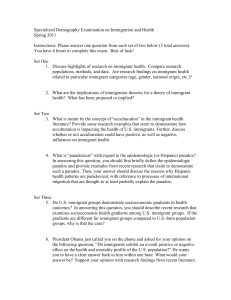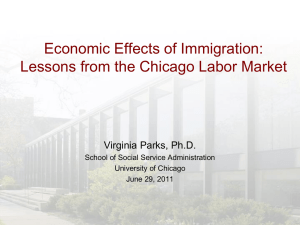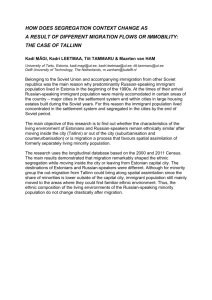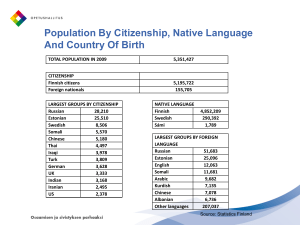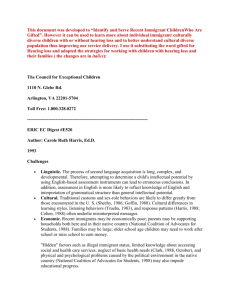The impact of immigration on the New Zealand labour market
advertisement
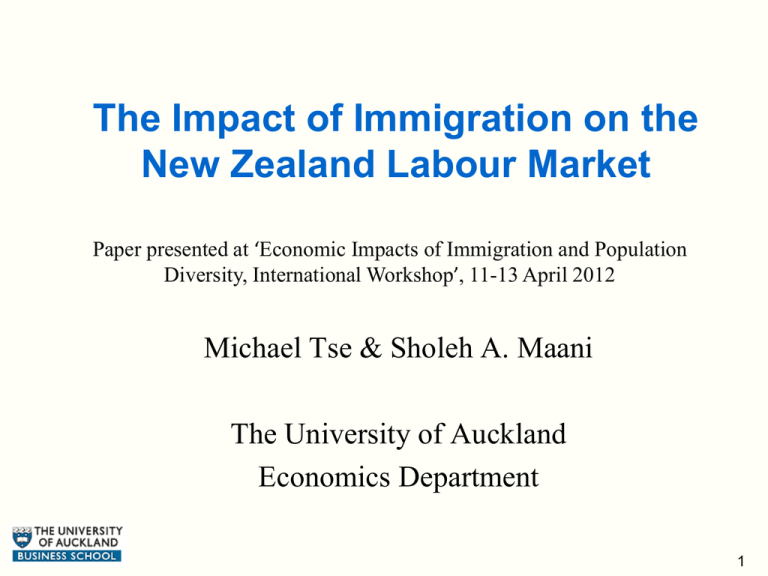
The Impact of Immigration on the New Zealand Labour Market Paper presented at ‘Economic Impacts of Immigration and Population Diversity, International Workshop’, 11-13 April 2012 Michael Tse & Sholeh A. Maani The University of Auckland Economics Department 1 Question & Motivation • A large segment of the NZ population is foreign-born (almost a quarter). • A key policy question is whether or not immigration affects the labour market opportunities of the existing workforce? 2 The direction of the impact on existing workers is dependent on a number of factors. These include: • Substitutability between immigrants and natives. Are immigrants and the native-born with similar educational qualifications complete substitutes? 3 Elasticity of substitution • If immigrants and natives are substitutes, then the inflow of immigrants would reduce wages in the labour market (Borjas, 2003; Orrenius & Zavodny, 2007) • If immigrants complement native workers, then we would expect positive changes to earnings from immigration (Ottaviano & Peri, 2007; Borjas, Grogger & Hanson, 2008) • 4 Immigrant education and experience • The value placed on education and experience acquired abroad is often less than the value placed on domestic education and experience (Lalonde & Topel, 1991; Duleep & Regets, 2002; Akresh, 2006; Antecol, Kuhn & Trejo, 2006) 5 International literature • Altonji & Card 1991 and Borjas 2003: 10 % point increase in fraction of immigrants reduces the wages of less skilled by 3-4 %. • Card 2005, Addison and Worswick 2002 : Mare’ and Stillman 2009, no significant adverse effect 6 Modelling approaches of wage effects for the native-born • 1. Spatial approach (Card, 1990, 2001, 2005; Altonji & Card, 1991; Dustmann, Fabbri & Preston, 2005). • 2. Factors of production approach • (Borjas, et al., 1996, 1997; Jaeger, 2007Leamer, 2000; Orrenius & Zavodny, 2007, Mare’ and Stillman, 2009). • 3. National level analysis (skill group) (Borjas, 2003, 2004, 2005; Orrenius & Zavodny, 2007). 7 Data • New Zealand Income Survey (NZIS), 2002 to 2007 • This is an individual level data released under the Confidentialised Unit Record File (CURF) format. 8 Modelling Approach • National level analysis based on skill and work experience categories • Wage effects of immigrant supply shocks Extensions: • We add spatial regional controls • We incorporate ‘effective immigrant experience’ 9 • Immigrant supply shock: • Pijt immigrant supply shock • M (Immigrant), N(Native-born) •i educational qualification •j experience group • t year 10 • 4 educational categories: • No schooling • School qualification (high-school completion) • Post-school • Bachelor or higher degree 11 Model • Immigrant shock, fixed-effects and interaction effects on earnings and hours worked: • Pijt •i •j •t immigrant supply shock educational qualification experience group year 12 13 Index of Congruence a native-born b immigrant c occupation (two-digit) Borjas (2003), Welch (1999) 14 15 Results • Immigrant shock, fixed effects and interaction effects: • Pijt •i •j •t immigrant supply shock educational qualification experience group year 16 19 Spatial Correlation • each cell is now defined as (r, i, j, t). That is, each cell is determined by a specific region, education level, experience group, and year. 20 21 22 Defining Effective Experience Let X be the effective experience of an immigrant worker: • A age • Am age at migration • AT age of labour force entry 23 • We estimate the three coefficients above in a standard immigrant assimilation regression of the form: • Ic = 1 • Id = 1 •N immigrant entered as a child if entry as adult native born 24 a = 0.4 experience overseas conversion m = 0.7 experience after migration t = 1.1 experience of child immigrants 25 26 Conclusions We extend the standard national level approach to incorporate local government regions in the analysis. • We defining groups by region-educationexperience, and it has some impact on the results, but the effect is small. 27 • We adjust for the value firms place on experience acquired abroad, and ‘effective experience’ for each worker. • Based on this experience framework the estimates of wage effects continue to be small. 28

